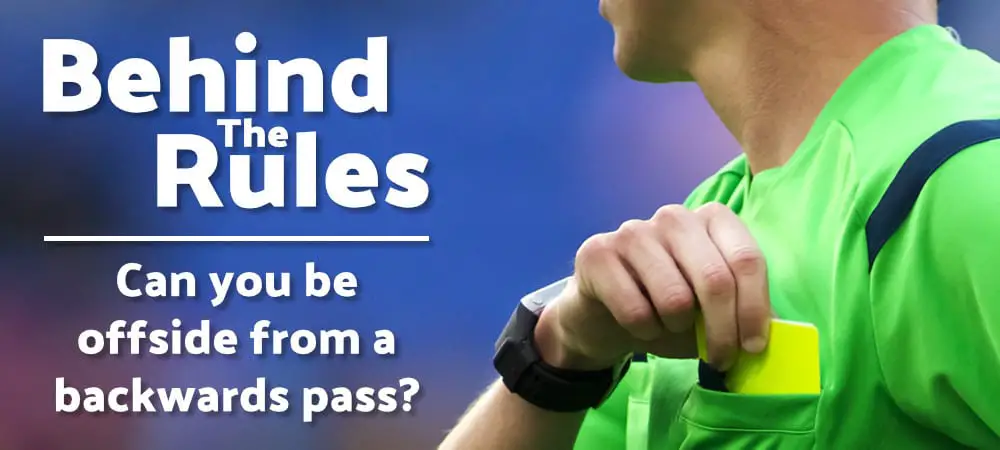Disclaimer: some of the links on this page are affiliate links. We will make a small commission on purchases made through them at no cost to you.
Once you wrap your head around it, the offside rule seems simple enough. Still, there are some unusual scenarios that leave even the most hardcore football fans scratching their heads. One of those is whether or not a player can be offside if they recieve the ball from a backwards pass.
So, can you be offside from a backwards pass? Yes, you can be offside from a backwards pass. If the recieving player is in an offside position when the pass is played, the direction of the pass is irrelevant.
Maybe that leaves you sattisfied. If not, read on!
The rest of this article looks at when offsides from a backwards pass occur, whether or not there should be a rule change and why there is so much confusion around backwards passes and offsides.
The direction of pass is irrelevant
When it comes to the offside rule, the direction of the pass is irrelevent. A ball passed forwards, laterally or even backwards can be offside.
What’s important is the recieving players position when the ball is passed. If, when the ball is passed, the recieving player is nearer to the opposition’s goal line than both the ball and the second last opponent, then it is offside.
This means, if a player is coming back from an offside position, and the pass is played before they reached an onside position, the ball can be played backwards but it is still offside.
In the next section, you’ll find a video showing this in action.
When do offsides from a backwards pass occur?
It’s fairly common for an offside to be called on a player running back from an offside position, but they are usually forward passes. Offsides from a backwards pass are quite rare, but they occasionally happen when a short corner is played.
This happens in the video below.
What happened here was, Wolves took a short corner, then the corner taker received a pass (played backwards) from his team-mate. However, since the corner taker was in an offside position when the ball was played back to him, it was offside.
Before VAR, these calls were rarely picked up on since the player is running against the play towards an onside position which makes it much harder to call. And there were rarely any arguments from the defending team because the attacking team didn’t gain an advantage.
Should there be a rule change?
There is an argument that there should be a rule change to accomodate these situations, because like in the Wolves vs. Leicester example above, the Wolves player didn’t gain an advantage from being in an offside position.
The offside rule was introduced to prevent goal hanging, where a player would wait near the opposition goal hoping for a long ball to be played to him leading to a 1v1 with the keeper.
But in the Wolves vs. Leicester situation, this wasn’t the case at all and when the Wolves player received the ball, he was behind Leicester’s defence.
However, for the time being at least, backwards passes can be offside.
Where the confusion lies
There seems to be a common misconception that backwards passes can’t be offside (which is probably why you’re on this page!), so let’s have a look why that is.
If you read the offside rule carefuly, it states that the player recieving the ball must be behind the second last defender or the ball.
As long as the player is behind the ball, it doesn’t matter if there are any defenders between him and the goal line.
Whenever there’s a 2v1 situation between two attacking players and the goal keeper, you will often see the player in possession play a square ball to his team mate to score an easy goal.
Often, this pass is played backwards which leads people to believe that is what’s making the play onside. However, it’s the fact that the player is behind the ball that makes it onside, not the direction of the pass.
Hopefully this answers your question and clears up any confusion about backwards passes and offsides.
Thanks for reading!

This article confuses terms of backwards. I think most readers understand the term backwards as the ball is kicked by a player in the direction that is <= 90 degrees of their own goal line (in a direction towards their own goal). By this definition of backwards pass the receiving player can never be offsides. I think people just search for backwards pass be cause they don't know the "or the ball" part of the offsides rule.
This article perfectly explains all parts of the backwards pass – its all receiving players position at the time of pass relative to the ball! At first I was confused by what the article was saying about the Wolves example as that video is not viewable in the States, but it was just an example where the receiving player came back from an offsides position to get the ball that was passed backwards.
Thanks